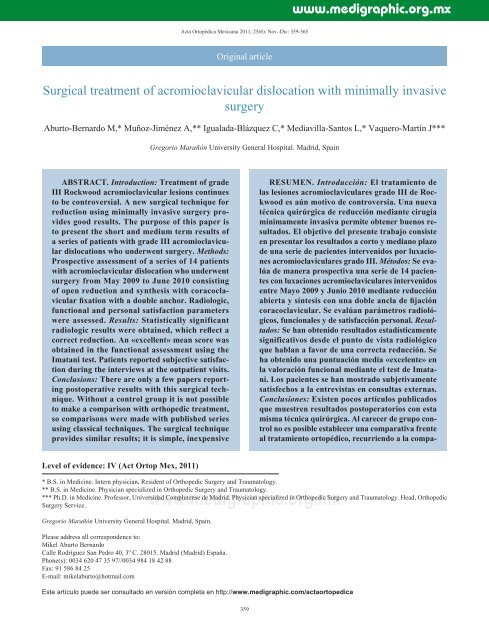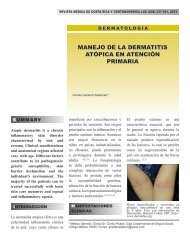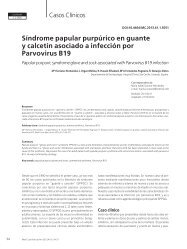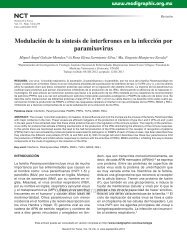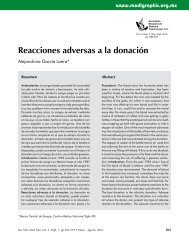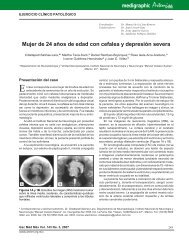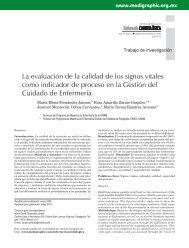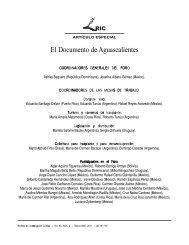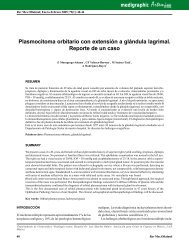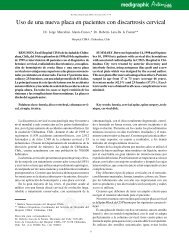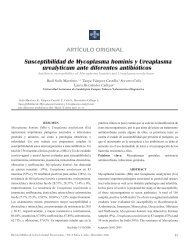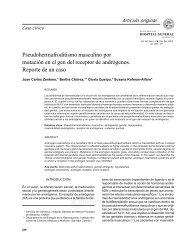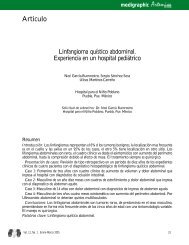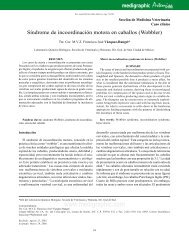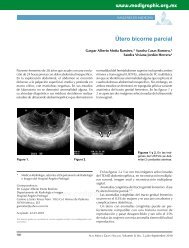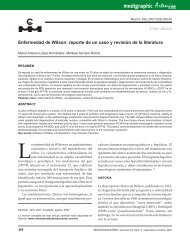Surgical treatment of acromioclavicular dislocation ... - edigraphic.com
Surgical treatment of acromioclavicular dislocation ... - edigraphic.com
Surgical treatment of acromioclavicular dislocation ... - edigraphic.com
Create successful ePaper yourself
Turn your PDF publications into a flip-book with our unique Google optimized e-Paper software.
Acta Ortopédica Mexicana 2011; 25(6): Nov.-Dic: 359-365<br />
Original article<br />
<strong>Surgical</strong> <strong>treatment</strong> <strong>of</strong> <strong>acromioclavicular</strong> <strong>dislocation</strong> with minimally invasive<br />
surgery<br />
Aburto-Bernardo M,* Muñoz-Jiménez A,** Igualada-Blázquez C,* Mediavilla-Santos L,* Vaquero-Martín J***<br />
ABSTRACT. Introduction: Treatment <strong>of</strong> grade<br />
III Rockwood <strong>acromioclavicular</strong> lesions continues<br />
to be controversial. A new surgical technique for<br />
reduction using minimally invasive surgery provides<br />
good results. The purpose <strong>of</strong> this paper is<br />
to present the short and medium term results <strong>of</strong><br />
a series <strong>of</strong> patients with grade III <strong>acromioclavicular</strong><br />
<strong>dislocation</strong>s who underwent surgery. Methods:<br />
Prospective assessment <strong>of</strong> a series <strong>of</strong> 14 patients<br />
with <strong>acromioclavicular</strong> <strong>dislocation</strong> who underwent<br />
surgery from May 2009 to June 2010 consisting<br />
<strong>of</strong> open reduction and synthesis with coracoclavicular<br />
fi xation with a double anchor. Radiologic,<br />
functional and personal satisfaction parameters<br />
were assessed. Results: Statistically significant<br />
radiologic results were obtained, which refl ect a<br />
correct reduction. An «excellent» mean score was<br />
obtained in the functional assessment using the<br />
Imatani test. Patients reported subjective satisfaction<br />
during the interviews at the outpatient visits.<br />
Conclusions: There are only a few papers reporting<br />
postoperative results with this surgical technique.<br />
Without a control group it is not possible<br />
to make a <strong>com</strong>parison with orthopedic <strong>treatment</strong>,<br />
so <strong>com</strong>parisons were made with published series<br />
using classical techniques. The surgical technique<br />
provides similar results; it is simple, inexpensive<br />
Level <strong>of</strong> evidence: IV (Act Ortop Mex, 2011)<br />
Gregorio Marañón University General Hospital. Madrid, Spain<br />
* B.S. in Medicine. Intern physician, Resident <strong>of</strong> Orthopedic Surgery and Traumatology.<br />
** B.S. in Medicine. Physician specialized in Orthopedic Surgery and Traumatology.<br />
*** Ph.D. in Medicine. Pr<strong>of</strong>essor, Universidad Complutense de Madrid. Physician specialized in Orthopedic Surgery and Traumatology. Head, Orthopedic<br />
Surgery Service.<br />
Gregorio Marañón University General Hospital. Madrid, Spain.<br />
Please address all correspondence to:<br />
Mikel Aburto Bernardo<br />
Calle Rodríguez San Pedro 40, 3º C. 28015. Madrid (Madrid) España.<br />
Phone(s): 0034 620 47 35 97//0034 984 18 42 88<br />
Fax: 91 586 84 25<br />
E-mail: mikelaburto@hotmail.<strong>com</strong><br />
www.m<strong>edigraphic</strong>.org.mx<br />
Este artículo puede ser consultado en versión <strong>com</strong>pleta en http://www.m<strong>edigraphic</strong>.<strong>com</strong>/actaortopedica<br />
359<br />
www.m<strong>edigraphic</strong>.org.mx<br />
RESUMEN. Introducción: El tratamiento de<br />
las lesiones <strong>acromioclavicular</strong>es grado III de Rockwood<br />
es aún motivo de controversia. Una nueva<br />
técnica quirúrgica de reducción mediante cirugía<br />
mínimamente invasiva permite obtener buenos resultados.<br />
El objetivo del presente trabajo consiste<br />
en presentar los resultados a corto y mediano plazo<br />
de una serie de pacientes intervenidos por luxaciones<br />
<strong>acromioclavicular</strong>es grado III. Métodos: Se evalúa<br />
de manera prospectiva una serie de 14 pacientes<br />
con luxaciones <strong>acromioclavicular</strong>es intervenidos<br />
entre Mayo 2009 y Junio 2010 mediante reducción<br />
abierta y síntesis con una doble ancla de fi jación<br />
coracoclavicular. Se evalúan parámetros radiológicos,<br />
funcionales y de satisfacción personal. Resultados:<br />
Se han obtenido resultados estadísticamente<br />
significativos desde el punto de vista radiológico<br />
que hablan a favor de una correcta reducción. Se<br />
ha obtenido una puntuación media «excelente» en<br />
la valoración funcional mediante el test de Imatani.<br />
Los pacientes se han mostrado subjetivamente<br />
satisfechos a la entrevistas en consultas externas.<br />
Conclusiones: Existen pocos artículos publicados<br />
que muestren resultados postoperatorios con esta<br />
misma técnica quirúrgica. Al carecer de grupo control<br />
no es posible establecer una <strong>com</strong>parativa frente<br />
al tratamiento ortopédico, recurriendo a la <strong>com</strong>pa-
and has not shown to have any postoperative <strong>com</strong>plications<br />
during a mean follow-up <strong>of</strong> 13.7 months.<br />
<strong>Surgical</strong> <strong>treatment</strong> <strong>of</strong> grade III <strong>acromioclavicular</strong><br />
lesions using this surgical technique has provided<br />
appropriate results in this group <strong>of</strong> patients.<br />
Key words: <strong>dislocation</strong>, shoulder, <strong>acromioclavicular</strong>,<br />
joint, surgery.<br />
Introduction<br />
Acromioclavicular joint injuries represent a frequent entity<br />
in the fi eld <strong>of</strong> traumatology; their estimated incidence<br />
is 10% <strong>of</strong> all <strong>dislocation</strong>s around the shoulder, with a large<br />
percent <strong>of</strong> undiagnosed cases. 1<br />
Depending on the energy <strong>of</strong> the injury the latter may be<br />
from a simple sprain all the way to <strong>com</strong>plete joint <strong>dislocation</strong>,<br />
with the possibility <strong>of</strong> associated clavicular or scapular<br />
bone fractures. Moreover, neighboring structures like the<br />
clavicular attachments <strong>of</strong> the deltoid muscles, the trapezium<br />
and the <strong>acromioclavicular</strong> fi brocartilage itself may be injured.<br />
The <strong>treatment</strong> <strong>of</strong> <strong>acromioclavicular</strong> joint injuries has always<br />
been controversial. The true debate takes place when<br />
deciding which is the best therapeutic option for grade III<br />
injuries, according to the Rockwood classifi cation, which<br />
involve <strong>com</strong>plete <strong>dislocation</strong> with moderate displacement<br />
<strong>of</strong> the distal end <strong>of</strong> the clavicle on a vertical plane. It is possible<br />
to prove that both the conservative and the surgical options<br />
have been popular recently. This paper shows the short<br />
and medium term results <strong>of</strong> a group <strong>of</strong> patients with Rockwood<br />
grade III acute <strong>acromioclavicular</strong> <strong>dislocation</strong>s that underwent<br />
a novel surgical procedure. The main hypothesis<br />
<strong>of</strong> this study is: are the postoperative results <strong>of</strong> the patients<br />
undergoing this procedure satisfactory from the radiological,<br />
functional and esthetic point <strong>of</strong> view? Secondarily, the<br />
results <strong>of</strong> other surgical techniques and orthopedic <strong>treatment</strong><br />
are <strong>com</strong>pared.<br />
Material and methods<br />
This paper presents a prospective study conducted at the<br />
Orthopedic Surgery and Traumatology Service at our hospital.<br />
It assessed the postoperative results <strong>of</strong> a series <strong>of</strong> 14<br />
patients with acute <strong>acromioclavicular</strong> <strong>dislocation</strong>s operated<br />
between May 2009 and June 2010.<br />
All patients had a history <strong>of</strong> trauma and presented at the<br />
Emergency Department in this center on the day <strong>of</strong> the injury.<br />
There were then diagnosed and immobilized with a<br />
sling. All patients were <strong>of</strong>fered the possibility <strong>of</strong> undergoing<br />
ACTA ORTOPÉDICA MEXICANA 2011; 25(6): 359-365<br />
Aburto-Bernardo M et al.<br />
www.m<strong>edigraphic</strong>.org.mx<br />
360<br />
ración con series publicadas con técnicas clásicas.<br />
La técnica quirúrgica <strong>of</strong>rece resultados similares,<br />
es sencilla, barata y no ha mostrado <strong>com</strong>plicaciones<br />
postoperatorias a un seguimiento medio de 13.7<br />
meses. El tratamiento quirúrgico de las lesiones<br />
<strong>acromioclavicular</strong>es grado III mediante esta técnica<br />
quirúrgica ha obtenido resultados satisfactorios<br />
en este grupo de pacientes.<br />
Palabras clave: dislocación, hombro, <strong>acromioclavicular</strong>,<br />
articulación, cirugía.<br />
surgery versus conservative <strong>treatment</strong>; the risks and benefi<br />
ts <strong>of</strong> each option were explained to them. They were also<br />
informed about this study. All <strong>of</strong> them signed an informed<br />
consent authorizing the surgery.<br />
The series was <strong>com</strong>posed <strong>of</strong> 14 patients, 13 males and<br />
one female, ages 18-53 years; mean age was 31.6 years.<br />
Eleven patients had Rockwood grade III pure <strong>acromioclavicular</strong><br />
<strong>dislocation</strong>s. Three <strong>of</strong> the patients had Neer IIB distal<br />
clavicular fractures, with a vertical and oblique fracture<br />
line between the clavicular attachments <strong>of</strong> the conoid and<br />
trapezoid ligaments. From a mechanical perspective this<br />
fracture is considered as an «<strong>acromioclavicular</strong> equivalent»,<br />
as the conoid ligament is torn and this produces a vertical<br />
displacement <strong>of</strong> the most medial clavicular fragment, which<br />
causes the highest risk <strong>of</strong> fracture pseudoarthrosis. 2 All patients<br />
were working and some <strong>of</strong> them had an associated<br />
condition at the time <strong>of</strong> the diagnosis.<br />
Surgery was performed within 3 days <strong>of</strong> the injury after<br />
the anesthetic assessment. All patients were operated by the<br />
same physician, with one exception.<br />
The implant used was the MINAR ® system (Minimal<br />
Invasive Reconstruction <strong>of</strong> the Acromioclavicular Joint)<br />
developed by Karl Storz GmbH ® (Dr. Karl-Storz-Str.<br />
34, 78532 Tuttlingen, Deutschland - 07461 7080) in collaboration<br />
with surgeons Pr<strong>of</strong>. Wolf Petersen (Trauma<br />
Surgery, Martin Luther Hospital, Berlin, Germany) and<br />
Dr. Thore Zantop (Trauma, Hand and Reconstructive<br />
Surgery, University Hospital, Münster, Germany). This<br />
system produces coracoclavicular stabilization by <strong>com</strong>bining<br />
a thread loop with a fixation double anchor or<br />
FLIPPTACK ® : one <strong>of</strong> the two anchors is placed under<br />
the lower aspect <strong>of</strong> the coracoid process, while the other<br />
one is placed on a vertical plane on the upper aspect <strong>of</strong><br />
the clavicle, and both are joined with a double knot <strong>of</strong> the<br />
non-absorbable suture.<br />
The surgical technique involves a single longitudinal 3-5<br />
cm skin incision, 3 cm medial from the <strong>acromioclavicular</strong><br />
joint. Protected drilling <strong>of</strong> a bone tunnel is performed on the<br />
clavicle and the coracoid process and the anchors are passed<br />
through it. Once tied, they secure the position <strong>of</strong> the clavicle<br />
when the <strong>dislocation</strong> is manually reduced.
ACTA ORTOPÉDICA MEXICANA 2011; 25(6): 359-365<br />
<strong>Surgical</strong> <strong>treatment</strong> <strong>of</strong> <strong>acromioclavicular</strong> <strong>dislocation</strong> with minimally invasive surgery<br />
Besides the placement <strong>of</strong> the implant, s<strong>of</strong>t tissue repair<br />
is also performed trying to suture the coracoclavicular ligament<br />
bundles with absorbable sutures and repair the deltotrapezoid<br />
fascia reanchoring it to the clavicle. The last step<br />
consists <strong>of</strong> suturing the subcutaneous plane and the skin<br />
without an aspiration drain.<br />
The technique used in the three patients with clavicular<br />
fracture was similar in everything. The fi xation anchor was<br />
placed in the most medial clavicular fragment, with the exception<br />
that an 8-shaped transosseous absorbable suture was<br />
used to reinforce stability in the anteroposterior plane.<br />
After a control X-ray within the fi rst 24-48 hours, and<br />
in the absence <strong>of</strong> medical <strong>com</strong>plications, patients were discharged.<br />
The operated limb was immobilized for two weeks with a<br />
sling; then specifi c rehabilitation was started. Patients were<br />
then asked to <strong>com</strong>e to the outpatient service at six weeks,<br />
four months and one year after surgery.<br />
Mean follow-up was 13.7 months. All the visits and<br />
questionnaire fi lling-out took place in the outpatient service.<br />
Three types <strong>of</strong> criteria were used for the evaluation <strong>of</strong> results:<br />
radiological, functional and esthetic, and those related<br />
with personal satisfaction.<br />
Anteroposterior and lateral axillary X-rays were performed<br />
in all patients including both the injured limb and the contralateral<br />
one, considered as a reference pattern (Figure 1).<br />
The following parameters <strong>of</strong> the anteroposterior X-rays<br />
were measured for the radiological study:<br />
• Width <strong>of</strong> the injured <strong>acromioclavicular</strong> (AC) joint, measured<br />
in millimeters, before and after surgery.<br />
• Coracoclavicular (CC) distance, measured in millimeters,<br />
<strong>of</strong> the injured joint, understood as the closest distance between<br />
these two structures, both before and after surgery.<br />
• The vertical clavicular displacement, measured in millimeters,<br />
<strong>of</strong> the injured joint, with respect to the tangent line <strong>of</strong><br />
the lower border <strong>of</strong> the <strong>acromioclavicular</strong> joint, both before<br />
and after surgery (Figure 2).<br />
• The presence <strong>of</strong> calcifi cations in <strong>acromioclavicular</strong> or<br />
coracoclavicular ligaments, clavicular or acromial osteolysis,<br />
and changes in the fracture line in the three cases<br />
with clavicular fracture.<br />
Figure 1. Anteroposterior X-ray <strong>of</strong> both shoulders showing a Rockwood<br />
grade III right <strong>acromioclavicular</strong> <strong>dislocation</strong>, with vertical shift <strong>of</strong> the clavicle<br />
and a certain drop <strong>of</strong> the scapulohumeral region <strong>com</strong>pared with the<br />
contralateral shoulder.<br />
www.m<strong>edigraphic</strong>.org.mx<br />
Mobility<br />
361<br />
• The <strong>acromioclavicular</strong> width and the coracoclavicular<br />
distance were measured in the non-injured limb X-rays<br />
and were considered as reference measures.<br />
The statistical study was conducted by the Preventive<br />
Medicine Service using the parametric or Student «t» test<br />
and calculating the statistically significant confidence intervals.<br />
Functional criteria were assessed using the Imatani test,<br />
shown in table 1, at the outpatient service between 6 weeks<br />
and 6 months after surgery.<br />
The esthetic result and personal satisfaction were assessed<br />
considering clavicular prominence as well as the<br />
surgical scar and its possible <strong>com</strong>plications (infection, hy-<br />
Table 1. Imatani Test.<br />
Total score Distribution<br />
Pain<br />
40 None<br />
25 Mild, occasional<br />
10 Moderate, tolerable, limits activities<br />
0 Serious, ongoing, disabling<br />
Function<br />
20 Weakness (percentage<br />
<strong>com</strong>pared to prior status)<br />
5 Shoulder use<br />
5 Modifi cation <strong>of</strong> activities<br />
10 Adduction<br />
10 Flexion<br />
10 Adduction<br />
Assessment <strong>of</strong> results<br />
B<br />
Figure 2. Parameters used for the radiographic assessment. A: Width <strong>of</strong><br />
the <strong>acromioclavicular</strong> joint. B: Coracoclavicular distance. C: Vertical shift<br />
<strong>of</strong> the clavicle.<br />
Score 90-100 Excellent Appropriate<br />
Score 80-89 Good Appropriate<br />
Score 70-79 Acceptable Not appropriate<br />
< 70 points Poor Not appropriate<br />
C<br />
A
pertrophy, keloid, hyperalgesia) and the psychologic aspects<br />
having to do with patients’ personal satisfaction and their<br />
perception <strong>of</strong> the result achieved.<br />
Results<br />
Acromioclavicular joint width, coracoclavicular distance<br />
and clavicular vertical displacement were all reduced<br />
in patients’ postoperative X-rays and approached the values<br />
measured in the contralateral shoulder, considered as a<br />
reference pattern. Assuming a normal distribution, applying<br />
the parametric Student «t» test, and calculating the confi -<br />
dence interval, we may say that there are no statistically signifi<br />
cant differences in the coracoclavicular distance between<br />
the postoperative results and the contralateral shoulder, with<br />
p ≤ 0.05, which leads to assume that this distance was fully<br />
corrected. There were, in turn, statistically signifi cant differences<br />
for the measurements <strong>of</strong> <strong>acromioclavicular</strong> width and<br />
vertical clavicular displacement between the postoperative<br />
results and the contralateral shoulder, with p ≤ 0.05, which<br />
leads to assume that these distances were not <strong>com</strong>pletely<br />
mm<br />
ACTA ORTOPÉDICA MEXICANA 2011; 25(6): 359-365<br />
Aburto-Bernardo M et al.<br />
Table 2. Comparison between postoperative results and the contralateral shoulder.<br />
Related differences<br />
95% Confi dence Sig. (bilateral)<br />
Std. Std. error interval for the difference gl Std. error<br />
Mean deviation <strong>of</strong> the mean Upper Lower t Std. deviation <strong>of</strong> the mean<br />
Pair 1 AC width (Post) - .9929 1.9793 .5290 -.1500 2.1357 1.877 13 .083<br />
AC width (Contra) -<br />
Pair 2 CC Distance (Post) - 1.3643 1.9492 .5209 .2388 2.4897 2.619 13 .021<br />
CC Distance (Contra) -<br />
Pair 3 Clavicular vertical shift (Post) - .7714 2.0345 .5437 -.4032 1.9461 1.419 13 .179<br />
Clavicular vertical shift (Contra) -<br />
30<br />
25<br />
20<br />
15<br />
10<br />
5<br />
0<br />
AC width<br />
(PREOP)<br />
*Patient with technique failure.<br />
www.m<strong>edigraphic</strong>.org.mx<br />
*<br />
AC width<br />
(POSTOP)<br />
AC width (CON-<br />
TRALATERAL)<br />
Chart 1. Box diagram representing the evolution <strong>of</strong> <strong>acromioclavicular</strong><br />
width and how it <strong>com</strong>pares with the contralateral shoulder.<br />
*<br />
362<br />
corrected as there was a mean difference <strong>of</strong> 1 and 1.6 millimeters,<br />
respectively.<br />
The statistical results and the value distribution charts<br />
are shown in table 2 and charts 1, 2 and 3. They show that<br />
one <strong>of</strong> the patients had <strong>com</strong>paratively higher postoperative<br />
values than the rest <strong>of</strong> the series; he was the only patient in<br />
the series with surgical technique failure and with clinical<br />
and radiological reproduction <strong>of</strong> the articular <strong>dislocation</strong>.<br />
This failure was due to a failed surgical indication, as the<br />
patient was diagnosed with a grade III <strong>acromioclavicular</strong><br />
<strong>dislocation</strong> without noticing that he also had fracture <strong>of</strong> the<br />
coracoid process and the scapular body, and coracoclavicular<br />
fi xation is not effective for this problem. This patient<br />
required a second surgery based on rigid <strong>acromioclavicular</strong><br />
fi xation, in this case using Phemister’s technique.<br />
No cases <strong>of</strong> peri-implant osteolysis have been documented;<br />
but 3 cases <strong>of</strong> coracoclavicular ligament ossification<br />
without clinical repercussions have been reported. Postoperative<br />
changes may be seen in the control X-ray in fi gure 3.<br />
Functionality was assessed with the Imatani test, applied<br />
during a visit at the outpatient service after postoperative<br />
mm<br />
25<br />
20<br />
15<br />
10<br />
5<br />
CC Distance<br />
(PREOP)<br />
CC Distance<br />
(POSTOP)<br />
CC Distance (CON-<br />
TRALATERAL)<br />
Chart 2. Box diagram representing the evolution <strong>of</strong> the coracoclavicular<br />
distance and how it <strong>com</strong>pares with the contralateral shoulder.
<strong>Surgical</strong> <strong>treatment</strong> <strong>of</strong> <strong>acromioclavicular</strong> <strong>dislocation</strong> with minimally invasive surgery<br />
week six. Three <strong>of</strong> the patients did not undergo the test because<br />
they were seen by a different surgeon, so only the results<br />
<strong>of</strong> the 11 remaining patients are included.<br />
The results obtained are shown in table 3. The mean total<br />
score was 90.18, which represents an overall «excellent»<br />
result. Eight <strong>of</strong> the patients achieved «excellent» results (accounting<br />
for 72%), 2 «good» results, and one patient had an<br />
«acceptable» result due to a poor score in the «pain» item.<br />
The only patient with surgical technique failure was not interviewed<br />
because he was reoperated on, but including him<br />
in the study may represent a decrease in the overall mean<br />
score.<br />
The highest score was obtained in the «mobility» item,<br />
as all patients interviewed had the same score <strong>of</strong> 30 points,<br />
which corresponds to full range <strong>of</strong> motion.<br />
Concerning the degree <strong>of</strong> personal satisfaction and esthetic<br />
results, there was a single case <strong>of</strong> clavicular prominence<br />
seen at the outpatient visits, without clinical or radiological<br />
correlation. There were no cases <strong>of</strong> infection,<br />
mm<br />
25<br />
20<br />
15<br />
10<br />
5<br />
0<br />
Clavicular<br />
vertical shift<br />
(PREOP)<br />
* Patient with technique failure.<br />
Clavicular<br />
vertical shift<br />
(POSTOP)<br />
Chart 3. Box diagram representing the evolution <strong>of</strong> the vertical shift <strong>of</strong> the<br />
clavicle and how it <strong>com</strong>pares with the contralateral shoulder.<br />
Este documento es elaborado por M<strong>edigraphic</strong><br />
Figure 3. Appropriate result in a postoperative control X-ray.<br />
ACTA ORTOPÉDICA MEXICANA 2011; 25(6): 359-365<br />
Clavicular vertical<br />
shift (CONTRA-<br />
LATERAL)<br />
www.m<strong>edigraphic</strong>.org.mx<br />
363<br />
hypertrophic scar, hyperalgesia or keloid. All patients were<br />
satisfi ed with the results obtained. In all cases patients returned<br />
to work within less than two months. Since we did<br />
not use an analog scale to measure the patients’ degree <strong>of</strong><br />
satisfaction, we cannot draw further conclusions.<br />
Discussion<br />
Based on the above mentioned data, the short and medium<br />
term results are satisfactory for this group <strong>of</strong> patients,<br />
both from the radiological and the functional and esthetic<br />
standpoints. There was one case <strong>of</strong> technique failure, which<br />
supposes a 7% that could have been avoided with the right<br />
diagnosis. From the radiological standpoint, statistically signifi<br />
cant results were obtained. Moreover, 90% <strong>of</strong> functional<br />
results were satisfactory, which coincides with the data <strong>of</strong><br />
other bibliographic series.<br />
There are, however, several limitations that prevent us<br />
from extending the conclusions <strong>of</strong> the study. There is no<br />
control group or <strong>com</strong>parative patient cohort to assess postoperative<br />
results versus conservative <strong>treatment</strong>. This limits<br />
the discussion and forces us to turn to historical cohorts.<br />
Imatani’s functional test and the radiological measures used<br />
in this study may not apply to other papers addressing this<br />
pathology, which would make it diffi cult to <strong>com</strong>pare results.<br />
We may not conclude if surgical <strong>treatment</strong> is the best option<br />
for this group <strong>of</strong> patients; we may only point out that<br />
the results obtained with this surgical technique have been<br />
satisfactory. There is also the need to prolong the followup<br />
to assess the long-term results. Even though statistically<br />
signifi cant results were obtained, the patient number in this<br />
series should increase to draw more consistent conclusions.<br />
The surgical technique used has a series <strong>of</strong> advantages<br />
<strong>com</strong>pared to other types <strong>of</strong> <strong>acromioclavicular</strong> reduction<br />
techniques.<br />
First <strong>of</strong> all, it produces an anatomical stabilization that<br />
could contribute to better long-term results. It also involves<br />
a temporary stabilization, as the implant exerts its role until<br />
the capsular and ligament healing process begins, which is<br />
estimated to occur at around four weeks. This could produce<br />
a long-term benefit <strong>com</strong>pared to other replacement<br />
techniques. Since no implant failure occurs during the fi rst<br />
weeks, it is likely that it will not occur later on. The surgery<br />
is affordable and simple; it does not require neither fancy<br />
instruments nor a long operative time, which is estimated<br />
between 30 and 45 minutes. As this is an open reduction<br />
technique it does not require arthroscopic assistance. The<br />
surgical incision is small, same as the implant, so the need<br />
to remove it has not been described, and this avoids a second<br />
surgery. No fi xation material intolerance or fatigue has<br />
occurred. The only case where the fi xation failed resulted<br />
from not making a correct diagnosis <strong>of</strong> the patient’s injuries.<br />
Had the diagnosis been correct, this type <strong>of</strong> surgery would<br />
not have been indicated.<br />
Given that the surgical technique described herein was<br />
introduced only recently (less than fi ve years ago), there are
ACTA ORTOPÉDICA MEXICANA 2011; 25(6): 359-365<br />
Aburto-Bernardo M et al.<br />
Table 3. Results <strong>of</strong> Imatani test.<br />
Use Change in<br />
Patient Pain Weakness shoulder activities Abduction Flexion Adduction Total<br />
1 30 20 5 5 10 10 10 90<br />
2 35 20 5 5 10 10 10 95<br />
3 10 20 5 5 10 10 10 70<br />
4 35 15 5 4 10 10 10 89<br />
5 40 20 5 5 10 10 10 100<br />
6 29 15 4 5 10 10 10 83<br />
7 35 20 5 5 10 10 10 95<br />
8 35 18 4 5 10 10 10 92<br />
9 35 15 5 5 10 10 10 90<br />
10 33 18 5 5 10 10 10 91<br />
11 37 20 5 5 10 10 10 97<br />
Mean 32.18 18.27 4.818 4.90 10 10 10 90.18<br />
no prospective trials including a long-term follow-up <strong>of</strong> patients<br />
operated with this surgical technique.<br />
Other studies provide information on arthroscopic fi xation<br />
with a very similar implant, with good clinical and<br />
radiological results at the 2-year follow-up in a 20-patient<br />
series. 3,4 However, despite the larger surgical approach used<br />
when performing reduction with an open technique, the latter<br />
is technically less diffi cult, the operative time is shorter,<br />
the cost is less and reconstruction is more anatomical. With<br />
the open technique it is possible to also repair the ligament<br />
<strong>com</strong>plex which is sacrifi ced with the arthroscopic technique<br />
in order to achieve a better vision <strong>of</strong> the fi eld (particularly<br />
the coracoclavicular and the upper and mid glenohumeral<br />
ligaments).<br />
A similar surgical technique consists <strong>of</strong> reduction under<br />
a coracoclavicular cerclage with either absorbable or nonabsorbable<br />
sutures. However, since this is a less strong fi xation,<br />
<strong>com</strong>plications may occur, like anterior clavicular subluxation<br />
or suture rupture as a result <strong>of</strong> the arm’s rotation<br />
movements.<br />
The classic Bosworth 6 coracoclavicular fixation technique<br />
has certain inconveniences such as the diffi culty to<br />
control anteroposterior clavicular displacement or the impossibility<br />
<strong>of</strong> repairing the ligament <strong>com</strong>plex. There are<br />
technique modifi cations that use absorbable materials with<br />
similar results.<br />
One <strong>of</strong> the most widely used techniques is <strong>acromioclavicular</strong><br />
rigid fi xation using Steinmann pins, Kirschner nails<br />
or the more recent hook plate.<br />
Phemister’s technique 7 is technically simple and little<br />
invasive; however, it does not allow achieving an anatomi-<br />
cal stabilization or s<strong>of</strong>t tissue reconstruction. To do this, an<br />
italic «S»-shaped broad incision is required, which could increase<br />
the risk <strong>of</strong> <strong>com</strong>plications.<br />
The hook plate has been related with a higher <strong>com</strong>plication<br />
rate and does not represent an advantage over other<br />
implants from this group.<br />
There are no <strong>com</strong>parisons in the literature between <strong>acromioclavicular</strong><br />
fi xation techniques and the coracoclavicular<br />
fi xation technique described herein.<br />
References<br />
www.m<strong>edigraphic</strong>.org.mx<br />
364<br />
Other types <strong>of</strong> surgical techniques based on ligament<br />
reconstruction, such as coracoacromial ligament transfer<br />
or the Weaver-Dunn technique, 8 involve little acceptance<br />
as isolated techniques and should be associated with other<br />
techniques like <strong>acromioclavicular</strong> or coracoclavicular fi xation.<br />
9<br />
In this paper it was not possible to assess postoperative<br />
results related with the orthopedic <strong>treatment</strong>, as there was<br />
no control group.<br />
Conclusions<br />
Several conclusions may be drawn as an answer to the<br />
questions posed at the beginning <strong>of</strong> this paper. <strong>Surgical</strong><br />
<strong>treatment</strong> <strong>of</strong> Rockwood grade III <strong>acromioclavicular</strong> <strong>dislocation</strong>s<br />
using this surgical technique has provided appropriate<br />
results in this group <strong>of</strong> patients. The surgical technique has<br />
proven to be simple, brief and effective. During the followup<br />
no infectious or other type <strong>of</strong> <strong>com</strong>plications have been<br />
described that result in implant removal.<br />
However, a <strong>treatment</strong> algorithm cannot be established<br />
because both conservative <strong>treatment</strong> and the different surgical<br />
techniques have yielded good results according to the<br />
literature. New studies and meta-analyses are necessary to<br />
draw additional conclusions.<br />
Since this is a prospective study, additional conclusions<br />
are expected when the number <strong>of</strong> patients is increased and<br />
the follow-up period is prolonged, as we intend to do.<br />
1. Urist MR: “Complete <strong>dislocation</strong> <strong>of</strong> the <strong>acromioclavicular</strong> joint”. J<br />
Bone Joint Surg Am 1963; 45: 1750-3.<br />
2. Wurtz LD, Lyons FA, Rockwood CA: “Fracture <strong>of</strong> the middle third <strong>of</strong><br />
the clavicle and <strong>dislocation</strong> <strong>of</strong> the <strong>acromioclavicular</strong> joint. A report <strong>of</strong><br />
four cases”. J Bone Joint Surg Am 1992; 74(1): 133-7.<br />
3. Arthrex Inc. (2006) “Arthroscopic stabilization <strong>of</strong> acute <strong>acromioclavicular</strong><br />
joint <strong>dislocation</strong> using the Thight Rope System: <strong>Surgical</strong> technique”.<br />
Naples, FL; Arthrex, 2006.<br />
4. Richards A, Potter D, Learmonth D, Tennent D: “Arthroscopic stabilization<br />
<strong>of</strong> acute distal clavicle fractures and <strong>dislocation</strong>s using Tight<br />
Rope syndesmosis repair system”. Presented at the Annual Meeting
<strong>Surgical</strong> <strong>treatment</strong> <strong>of</strong> <strong>acromioclavicular</strong> <strong>dislocation</strong> with minimally invasive surgery<br />
<strong>of</strong> the Arthroscopy Association <strong>of</strong> North America, Vancouver, BC,<br />
May 2005.<br />
5. Wellmann M, Zantop T, Petersen V: “Minimally invasive coracoclavicular<br />
ligament augmentation with a fl ip button/polydioxanone repair<br />
for <strong>treatment</strong> <strong>of</strong> total <strong>acromioclavicular</strong> joint <strong>dislocation</strong>”. Arthroscopy<br />
2007; 23(10): 1132 e1-5.<br />
6. Bosworth BM: “Acromioclavicular <strong>dislocation</strong>: End-results <strong>of</strong> screw<br />
suspension <strong>treatment</strong>”. Ann Surg 1948; 127(1): 98-111.<br />
7. Corella F, Ortiz-Espada A, López-Capapé D, Ocampos-Hernández,<br />
Calvo-Haro JA, Vaquero-Martín J: “Tratamiento quirúrgico de las<br />
ACTA ORTOPÉDICA MEXICANA 2011; 25(6): 359-365<br />
www.m<strong>edigraphic</strong>.org.mx<br />
365<br />
luxaciones <strong>acromioclavicular</strong>es con la técnica de Phemister. Revisión<br />
de resultados a largo plazo”. Patología del Aparato Lo<strong>com</strong>otor 2006;<br />
4(13): 157-66.<br />
8. Warren-Smith CD, Ward MW. “Operation for <strong>acromioclavicular</strong> <strong>dislocation</strong>.<br />
A review <strong>of</strong> 29 cases treated by one method”. J Bone Joint<br />
Surg Br 1987; 69(5): 715-8.<br />
9. Shin SJ, Yun YH, Yoo JD: “Coracoclavicular ligament reconstruction<br />
for <strong>acromioclavicular</strong> <strong>dislocation</strong> using 2 suture anchors and<br />
coracoacromial ligament transfer”. Am J Sports Med 2009; 37(2):<br />
346-51.


